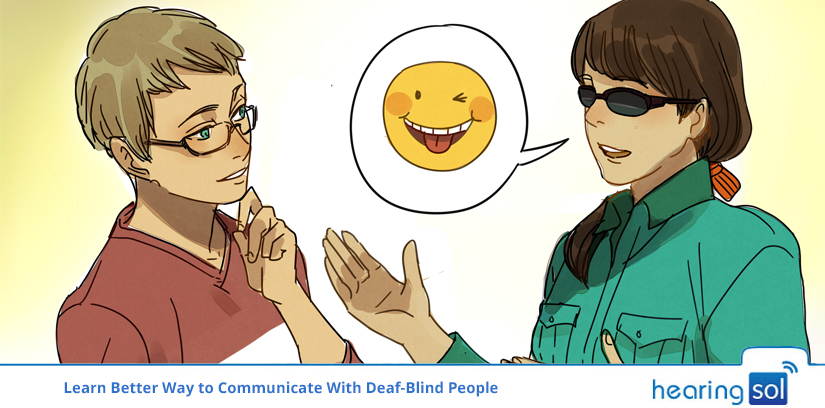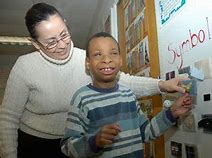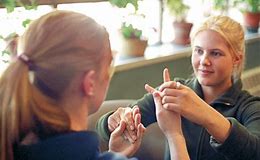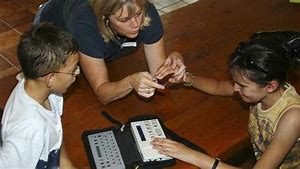
Having a disability can truly affect many aspects of anyone’s life. But try to ask yourself about this, what if you had, not only one, but two disabilities? You may probably think, “Most likely I would stay at home and have someone to take care of me the whole day.”
You can purchase the latest hearing aids at a fair price through HearingSol, If you need any assistance or you have a query regarding Deaf-Blind People or Hearing Loss, feel free to call us at +91-9327901950. We are always here to help you.
Well, you are not the only one having this thinking, there are many other people who would have think of the same thing. But let’s read and learn more in detail about blind and deaf communication and their various techniques to deal with it.
Blind and Deaf
Deafblindness is a combination of vision and hearing loss that causes difficulties with communication. It is also referred to as dual sensory loss or impairment. You can also refer to them as multiple disabilities or multiple disorders. If you know someone who is suffering from this problem, then you could treat them purely differently than you do with normal peoples. You could love and care for them more.

People suffering from deafblindness are either totally deaf and blind or some having a partial hearing and vision loss. This article describes different sign language and method of communication they used to communicate with each other.
There are two types of deaf-blindness:
Congenital deaf-blindness: which means “born with” or “present from birth”. So, we use this term when someone is born with hearing and vision problems. This may happen when a baby contracts a disease or suffers an injury that results in loss of vision and hearing. It is the most difficult challenge for individuals.
It can be caused by these following ways:
- Effects of drugs
- Pregnancy complexities
- Genetic conditions starting from the birth
- From illness and infections
Acquired deaf-blindness: this is the condition when a person becomes deaf and blind after some age. The term “acquired deaf-blindness” generally refers to adults who become blind-deaf at an adult stage of their life.
It can be caused due to:
- Genetic conditions and occurs in an adult phase of life.
- Illness
- Tumour
- Head trauma
Question in mind how do blind and deaf communicate? Mentioned below
Understanding blind and deaf person communication
 Know that there are a variety of degrees of deaf and blindness or dual-sensory loss. People who are not able to communicate are not dumb, but instead, hold a great deal of potential for personal development.
Know that there are a variety of degrees of deaf and blindness or dual-sensory loss. People who are not able to communicate are not dumb, but instead, hold a great deal of potential for personal development.- There are many techniques to communicate with people who are deaf and blind including; Speech, Written communication, Graphic and non-tactile symbols, Tactile symbols and object cues, facial expression, Manual sign language.
- Take the blind-deaf person’s hands. Being hand-in-hand also allows for the continued communication through the physical connection.
- A small improvement can help both sight or ear loss people. Recommend medical advice about both senses.
- A person who is blind and deaf may communicate through the message. So take any card or word that is provided to you, in order that the person is aware of you’ve got the message.
- Wait for a sec before the response. According to a study waiting for 1, 5, or 10 seconds is more useful while interacting with the deaf and blind people.
- Be patient and sensitive to blind-deaf person and their needs. Your loved one’s happiness is more important than any amount of communication.
Methods of deaf-blind communication
People suffering from deaf-blindness have many ways of communication. The methods they use vary, depending on the causes of their combined vision and hearing loss, their backgrounds, and their education. Below are the most common ways they use.
 Irish Sign Language:-
Irish Sign Language:-
Irish Sign Language (ISL) is the sign language of Ireland, used by the vast majority of people who are deaf in the Republic of Ireland and in some parts of Northern Ireland. ISL has its own grammar and structure. It is different from other national sign languages such as British Sign Language (BSL) and American Sign language (ASL) but does have influenced others such as French Sign Language (LSF).
Tactile sign language:-
Tactile signing is a communication method that people use suffering from both an eye and hearing impairment. It is based on a sign language or other system of manual communication.
Lamh:-
It is the accepted manual sign system used by children and adults with disabilities in Ireland. These signs help them to communicate and to support their understanding. There are 500 Lámh signs, based on Irish Sign Language (ISL) and on natural gesture. Some users may use Lamh for some period of time and drop when their speech develops.
Picture Exchange / PECS:-
The Picture Exchange Communication System, or PECS, allows people who have eye and ear problems to communicate using pictures.
Braille:-
It is a system of raised dots that people who are visually impaired can be read with the help of their fingers. Braille is not a language. Though it is a code by which many languages—such as English, Spanish, Arabic, Chinese, and dozens of others—may be written and read. It is designed with raised dots that are arranged in the cell to six dots in a 3*2 configuration. Each cell represents a letter, numeral, or punctuation mark.
Swell symbols:-
It is tactile, lifted line drawings that allow people who are blind or vision impaired to feel maps and graphics with their fingertips. Swell paper is one method of making tactile images. Several factors affect their development
British Sign Language:-
It is for use mainly by people who are Deaf or have hearing impairments. British Sign Language (BSL) is a sign language that people use in the United Kingdom. BSL has its own grammar and principles, which are completely different from the grammatical structure of English.
There are additional ways also for communicating with blind-deaf people:
- Speech Lip-reading
- Key Word Signs
- Tracking
- Signs used on the body
- Co-active signing
- Deafblind manual alphabet
- Printing on palm
- Gestures
- Body language
- Facial expressions
- Behavior/Routines
- Pictures/photos
- Object symbols
- Written (large print writing or typed information)
- Use of communication devices
The outcome for deaf and blind communications in this article provides a number of different methods. Which is right will need to be determined by each individual. All methods must stress consistency, patience, and a high level of independence as the focus of efforts put on training, with the ultimate goal of developing meaningful human relationships.
Challenges for a DeafBlind person?
- Depending on others to feel safe and informed
- Learning and using communication strategies
- Becoming aware of and navigating their surroundings
- Overcoming barriers that complicate their interactions with Non DeafBlind people
- Finding social, living and employment situations that fit their individual talents, needs and aspirations
Also, for more information about communicator guides, you can contact us on our toll-free (+91-9327901950) which provides especially relevant support, advice, and information about deaf-blindness including information that can help or you can visit our HearingSol in Delhi NCR.
Refer more:

 Reviewed by Mr. Ranjeet Kumar
Sr. Audiologist, Speech Therapist & Cochlear Implant Specialist, BASLP on
Reviewed by Mr. Ranjeet Kumar
Sr. Audiologist, Speech Therapist & Cochlear Implant Specialist, BASLP on